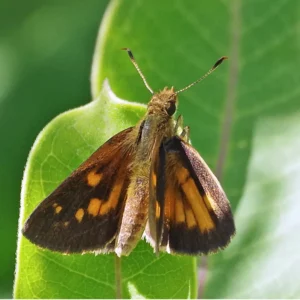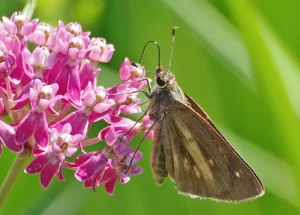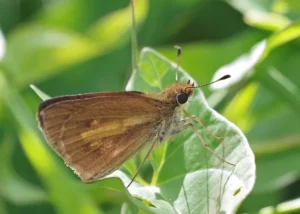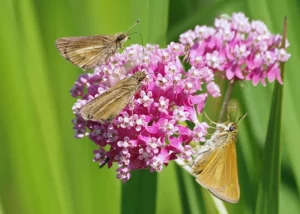Howdy, BugFans,
Last July, the BugLady made a couple of visits to a local wetland where she enjoyed an abundance of Broad-winged Skippers on swamp milkweed.
A brief introduction—broad-winged Skippers are in the family Hesperiidae (the Skippers). Most skippers are smallish butterflies with chunky bodies whose antennae have a tip that’s hooked to some degree, and while there are some colorful species out there, many are brown and orange (or orange and brown), just orange, or just brown.

They’re in the subfamily Hesperiinae, the Grass or Banded skippers—“Grass skippers” because the caterpillar host plants of many species are grasses and sedges. Adults are strong, if bouncy, flyers that nectar on flowers, and although they can fold their wings, many perch in a “jet plane” position, with the front pair of wings open in a “V,” and the hind pair of wings at a wider angle. Grass skipper caterpillars feed at night in nests they make in the grasses. They later form a chrysalis and overwinter there. There are about 140 species of Grass skippers in North America.
With wingspreads between 1-¼” and 2-¼,” Broad-winged Skippers (Poanes viator) are a large-ish skipper. Males and females look somewhat different (male), (female).

According to the “Butterflies of Massachusetts” website, the Broad-winged Skipper is “a beautiful insect with a long and venerable native history.” Its historical host plant in Massachusetts was wild rice (Zizania sp.). It turns out that there’s an Eastern/Gulf/lower Mississippi River coastal plain subspecies (Poanes viator zizaniae) and an inland subspecies that lives around the Great Lakes and westward to the Dakotas (Poanes viator viator). We now know that they can be distinguished by size and hindwing pattern, but early observers weren’t always discriminating about how they recorded them. The skipper is found in marshes and other wetlands, saltwater and fresh; the post glacial warming period allowed the species (and its food plant) to move back north from wherever it took refuge during the last glacier.
Today, though, another common name for the Broad-winged Skipper is “Phragmites Skipper” (or as one source called it “the butterfly you don’t want to see”). Here’s where it gets a little tricky—more subspecies. (And here’s where the BugLady disappeared down a botanical rabbit hole).
THE RABBIT HOLE: The genus Phragmites, a genus with just four species of perennial grasses, is considered one of the most widespread plant genera in the world, and Phragmites australis (formerly Phragmites communis), aka Reed grass or Common reed, is a major pest in wetlands across this continent. Of course, it’s not that simple—cue the subspecies! American reed, the subspecies Phragmites australis americanus (which is being considered for full species status) is native to North America, where it grows in bogs, fens, and along rivers, and where it has been used by Indians for millennia as food, beverage, twine, woven mats, arrows, cigarette “papers,” insulation, flutes, pipes, etc.
Sometime in the early 19th century (even earlier, say some sources), the very aggressive European subspecies Phragmites australis australis was introduced to North America, possibly in ballast water, and it has become a huge problem. Back in the Old Country, it was used for pen nibs, livestock food, and porridge, for thatching roofs, and, in the Netherlands, for reclamation of lands at the ocean’s edge. Most of the Phragmites we see today in the dense, brackish marshes along the Atlantic coast, researchers are hoping to find a “phrag-buster”—a plant that can out-compete it. Colonies of eight-foot-plus grasses, tipped with plumes of purplish seeds growing in our roadside ditches, are the European subspecies. It hasn’t been until relatively recently that people have felt confident about differentiating the two, and, undoubtedly, native colonies have taken a hit in the name of Phragmites control. Bottom line, Phragmites australis australis looks a little different than the native Phragmites australis americanus and it behaves differently too. The two don’t hybridize, except in laboratories.
BACK TO THE BUTTERFLIES—The coastal subspecies of the Broad-winged Skipper once fed on wild rice but has mostly switched to Phragmites, along with a little Marsh Millet (Zizaniopsis miliacea). You would think that latching onto an abundant food source like Phragmites would mean a population boom, and it’s true that there are more reports of Broad-winged Skippers in Massachusetts today, but its status there is still listed as “uncommon.” A note in “Butterflies of Massachusetts” points out that “There may be more Broad-wings than these [census] measures suggest, because larger concentrations may not be easily accessible, and may not have been fully counted. As Cassie pointed out in his Atlas account, ‘Broad-winged Skippers are found in greatest numbers within the Phragmites stands. A sizable population, slowly meandering through the reed stalks and keeping within the sanctuary of the reed bed, may be virtually invisible to the casual observer.’”

The host plant of our inland subspecies of Broad-winged Skipper is mostly Hairy sedge (Carex lacustris), and although its path may cross with wild rice and with Phragmites in the Great Lakes area, the caterpillar (supposedly) does not use them (Mike Reese, on his Wisconsin Butterflies website, says “Although this species is said to use Carex sedges as host plants in the Midwest, it does use Phragmites the east, and whether or not it uses this species here in Wisconsin, I have found it much more abundant where Phragmites does occur.”). The plot thickens.
Adults nectar on a variety of wetland plants, especially Swamp milkweed.
Who Were those Guys IX – William Henry Edwards
“Who Were Those Guys?” is a series that’s dedicated to the pioneering naturalists and entomologists who discovered new species when our country was young.
The Broad-winged Skipper was described and named by William Henry (W. H.) Edwards in 1865. Few of the entomologists of the 18th and 19th centuries entered the field of entomology through the front door—a common approach to natural history was often via the study of medicine (one dragonfly guy was a banker). W. H. Edwards (March 15, 1822 – April 2, 1909) was a businessman. He grew up on a huge family estate in upstate New York where his family ran a tannery, and it was there that his love of nature began.
He went to Williams College in Massachusetts because of its strong Natural History curriculum (though he chafed against the religious atmosphere of the school), and he went on to study law, but never practiced. In the decades before the Civil War, he ran one of the first large-scale coal mining businesses in the Kanawha Valley in West Virginia. In 1856, when he was in his 30’s, he started collecting butterflies, and he was soon corresponding with noted scientists of his time. Curiously, one correspondent was an English actor and entomologist named Henry Edwards.
By 1865, he had begun his magnum opus, the three-volume Butterflies of North America. The books took three decades to complete, and they feature 152 of what many consider the most outstanding illustrations of butterflies ever done. The cost of producing and hand-coloring the illustrations at a time when cheaper methods like lithography and photography were becoming available far exceeded his budget, and he had to sell his butterfly collection to the Carnegie Museum in order to complete the work. A first edition set of Butterflies of North America is worth over $10,000 today.
Along the way Edwards also wrote 265 scientific papers and proposed names for 356 species of butterflies plus a few Sphinx and Underwing moths. When he was 75 and Butterflies of North America was complete, he abandoned butterflies and turned his attention to Shakespeare and genealogy, but just before his 80th birthday, he penned his “Entomological Reminiscences.”
The BugLady
